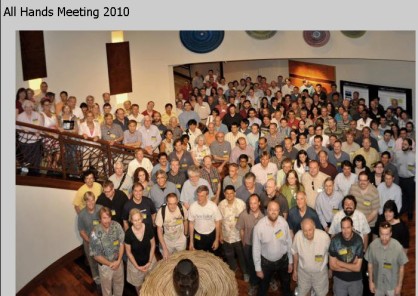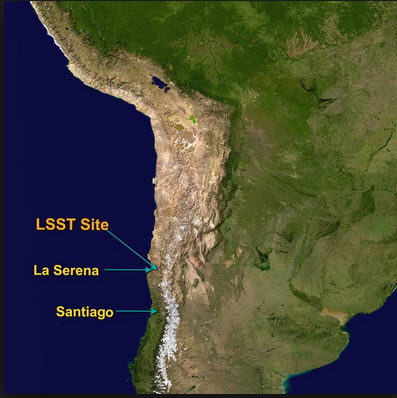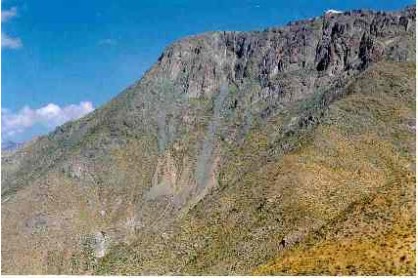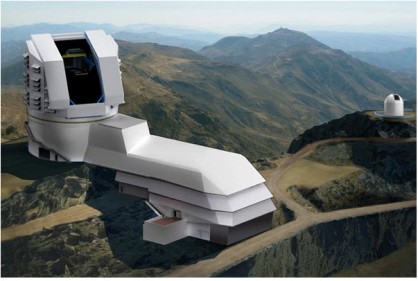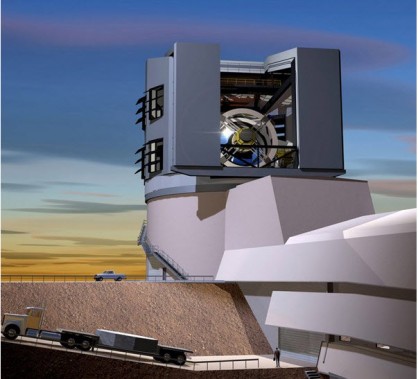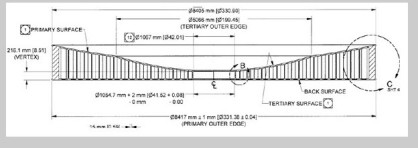THE TRUTH IS OUT THERE
February 6, 2015
In John 18:38 we read the following from the King James Version of the Bible: “Pilate saith unto him, What is truth? And when he had said this, he went out again unto the Jews, and saith unto them, I find in him no fault at all.” Pilate did not stay for an answer.
One of my favorite television programs was the “X”-Files. It’s been off the air for some years now but we are told will return as a “mini-series” sometime in the very near future. The original cast; i.e. Fox Mulder and Dana Skully will again remind us—THE TRUTH IS OUT THERE. The truth is definitely out there as indicated by the men and women comprising the Large Synoptic Survey Telescope team. They are definitely staying for answers. The team members posed for a group photograph as seen below.
THE MISSION:
The Large Synoptic Survey Telescope (LSST) structure is a revolutionary facility which will produce an unprecedented wide-field astronomical survey of our universe using an 8.4-meter ground-based telescope. The LSST leverages innovative technology in all subsystems: 1.) the camera (3200 Megapixels, the world’s largest digital camera), 2.) telescope (simultaneous casting of the primary and tertiary mirrors; 3.) two aspherical optical surfaces on one substrate), and 4.) data management (30 Terabytes of data nightly.) There will be almost instant alerts issued for objects that change in position or brightness.
The known forms of matter and types of energy experienced here on Earth account for only four percent (4%) of the universe. The remaining ninety-six percent ( 96 % ), though central to the history and future of the cosmos, remains shrouded in mystery. Two tremendous unknowns present one of the most tantalizing and essential questions in physics: What are dark energy and dark matter? LSST aims to expose both.
DARK ENERGY:
Something is driving the universe apart, accelerating the expansion begun by the Big Bang. This force accounts for seventy percent (70%) of the cosmos, yet is invisible and can only be “seen” by its effects on space. Because LSST is able to track cosmic movements over time, its images will provide some of the most precise measurements ever of our universe’s inflation. Light appears to stretch at the distant edges of space, a phenomenon known as red shift, and LSST may offer the key to understanding the cosmic anti-gravity behind it.
DARK MATTER:
Einstein deduced that massive objects in the universe bend the path of light passing nearby, proving the curvature of space. One way of observing the invisible presence of dark matter is examining the way its heavy mass bends the light from distant stars. This technique is known as gravitational lensing. The extreme sensitivity of the LSST, as well as its wide field of view, will help assemble comprehensive data on these gravitational lenses, offering key clues to the presence of dark matter. The dense and mysterious substance acts as a kind of galactic glue, and it accounts for twenty-five percent (25 %) of the universe.
From its mountaintop site, LSST will image the entire visible sky every few nights, capturing changes over time from seconds to years. Ultimately, after 10 years of observation, a stunning time-lapse movie of the universe will be created.
As the LSST stitches together thousands of images of billions of galaxies, it will process and upload that information for applications beyond pure research. Frequent and real time updates – 100 thousand a night – announcing the drift of a planet or the flicker of a dying star will be made available to both research institutions and interested astronomers.
In conjunction with platforms such as Google Earth, LSST will build a 3D virtual map of the cosmos, allowing the public to fly through space from the comfort of home. ALLOWING THE PUBLIC is the operative phrase.. For the very first time, the public will have access to information, as it is presented, relative to the cosmos. LSST educational materials will clearly specify National and State science, math and technology standards that are met by the activity. Our materials will enhance 21st century workforce skills, incorporate inquiry and problem solving, and ensure continual assessment embedded in instruction.
THE LOCATION:
The decision to place LSST on Cerro Pachón in Chile was made by an international site selection committee based on a competitive process. In short, modern telescopes are located in sparsely populated areas (to avoid light pollution), at high altitudes and in dry climates (to avoid cloud cover). In addition to those physical concerns, there are infrastructure issues. The ten best candidate sites in both hemispheres were studied by the site selection committee. Cerro Pachón was the overall winner in terms of quality of the site for astronomical imaging and available infrastructure. The result will be superb deep images from the ultraviolet to near infrared over the vast panorama of the entire southern sky.
The location is shown by the following digital:
The actual site location, as you can see below, is a very rugged outcropping of rock now used by farmers needing food for their sheep.
The Observatory will be located about 500km (310.6856 miles )north of Santiago, Chile, about 52km (32.3113 miles) or 80km (49.7097 miles) by road from La Serena, at an altitude of 2200 meters (7217.848 feet). It lies on a 34,491Ha (85,227 acres.) site known as “Estancia El Tortoral” which was purchased by AURA on the open market in 1967 for use as an astronomical observatory.
When purchased, the land supported a number of subsistence farmers and goat herders. They were allowed to continue to live on the reserve after it was purchased by AURA and have gradually been leaving voluntarily for more lucrative jobs in the nearby towns.
As a result of departure of most of its human inhabitants and a policy combining environmental protection with “benign neglect” on the part of the Observatory, the property sees little human activity except for the roads and relatively small areas on the tops of Cerro Tololo and Cerro Pachon. As a result, much of the reserve is gradually returning to its natural state. Many native species of plants and animals, long thought in danger of extinction, are now returning. The last half of the trip to Tololo is an excellent opportunity to see a reasonably intact Chilean desert ecosystem.
THE FACILITY:
LSST construction is underway, with the NSF funding authorized as of 1 August 2014.
Early development was funded by a number of small grants, with major contributions in January 2008 by software billionaire Charles Simonyi and Bill Gates of $20 and $10 million respectively. $7.5 million is included in the U.S. President’s FY2013 NSF budget request. The Department of Energy is expected to fund construction of the digital camera component by the SLAC National Accelerator Laboratory, as part of its mission to understand dark energy.
Construction of the primary mirror at the University of Arizona‘s Steward Observatory Mirror Lab, the most critical and time-consuming part of a large telescope’s construction, is almost complete. Construction of the mold began in November 2007, mirror casting was begun in March 2008, and the mirror blank was declared “perfect” at the beginning of September 2008. In January 2011, both M1 and M3 figures had completed generation and fine grinding, and polishing had begun on M3.
As of December 2014, the primary mirror is completed awaiting final approval, and the mirror transport box is ready to receive it for storage until it is shipped to Chile.
The secondary mirror was manufactured by Corning of ultra low expansion glass and coarse-ground to within 40 μm of the desired shape. In November 2009, the blank was shipped to Harvard University for storage until funding to complete it was available. On October 21, 2014, the secondary mirror blank was delivered from Harvard to Exelis for fine grinding.
Site excavation began in earnest March 8, 2011, and the site had been leveled by the end of 2011. Also during that time, the design continued to evolve, with significant improvements to the mirror support system, stray-light baffles, wind screen, and calibration screen.
In November 2014, the LSST camera project, which is separately funded by the United States Department of Energy , passed its “critical decision 2” design review and is progressing toward full funding.
When completed, the facility will look as follows with the mirror mounted as given by the second JPEG:
MIRROR DESIGN:
The assembled mirror structure is given below.
In the LSST optical design, the primary (M1) and tertiary (M3) mirrors form a continuous surface without any vertical discontinuities. Because the two surfaces have different radii of curvature, a slight cusp is formed where the two surfaces meet, as seen in the figure below. This design makes it possible to fabricate both the primary and tertiary mirrors from a single monolithic substrate. We refer to this option as the M1-M3 monolith.
After a feasibility review was held on 23 June 2005, the LSST project team adopted the monolithic approach to fabricating the M1 and M3 surfaces as its baseline. In collaboration with the University of Arizona and Steward Observatory Mirror Lab (SOML) construction has begun with detailed engineering of the mirror blank and the testing procedures for the M1-M3 monolith. The M1-M3 monolith blank will be formed from Ohara E6 low expansion glass using the spin casting process developed at SOML.
At 3.42 meters in diameter the LSST secondary mirror will be the largest convex mirror ever made. The mirror is aspheric with approximately 17 microns of departure from the best-fit sphere. The design uses a 100 mm thick solid meniscus blank made of a low expansion glass (e.g. ULE or Zerodur) similar to the glasses used by the SOAR and Discovery Chanel telescopes. The mirror is actively supported by 102 axial and 6 tangent actuators. The alignment of the secondary to the M1-M3 monolith is accomplished by the 6 hexapod actuators between the mirror cell and support structure. The large conical baffle is necessary to prevent the direct reflection of star light from the tertiary mirror into the science camera.
SUMMARY:
The truth is out there and projects such as the one described in this post AND the Large Hadron Collider at CERN certainly prove some people and institutions are not at all reluctant to search for that truth, the ultimate purpose being to discover where we come from. Are we truly made from “star stuff”?
